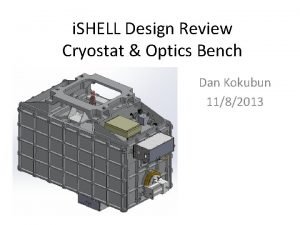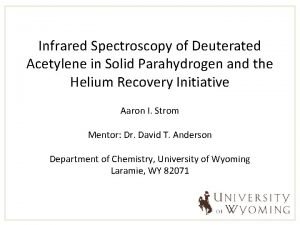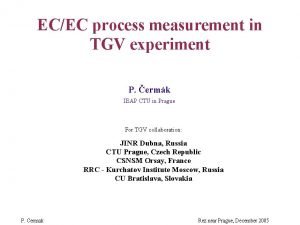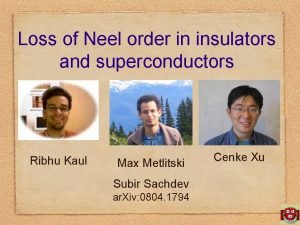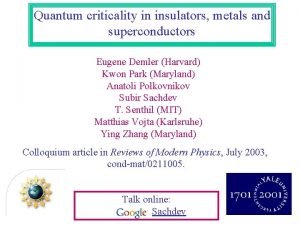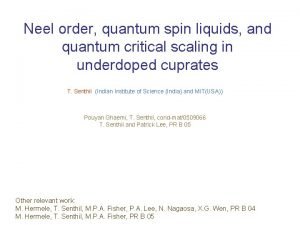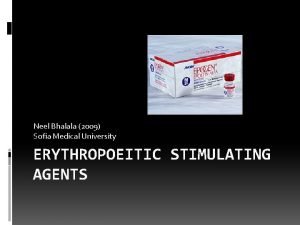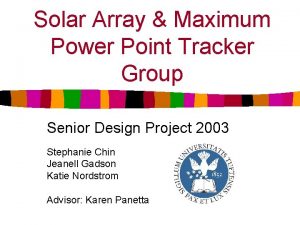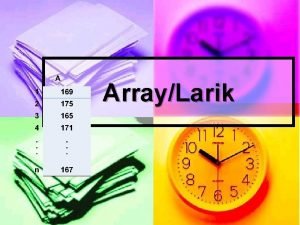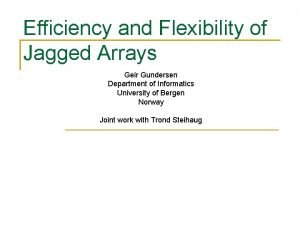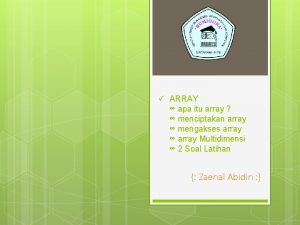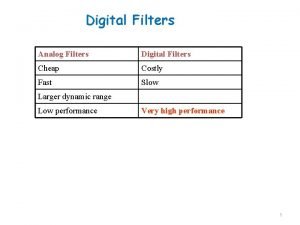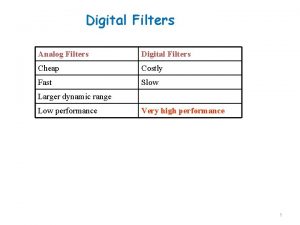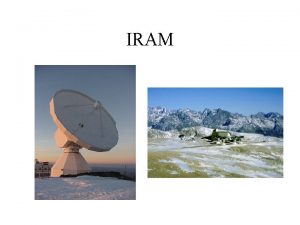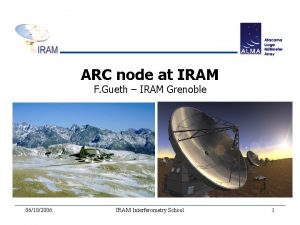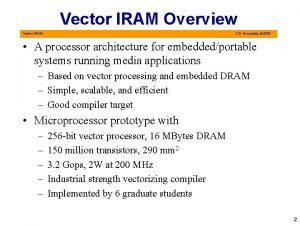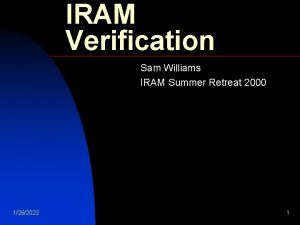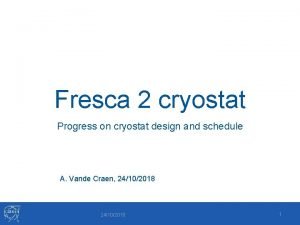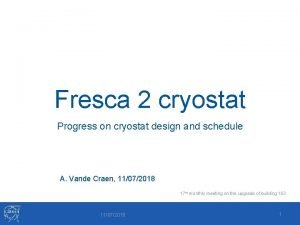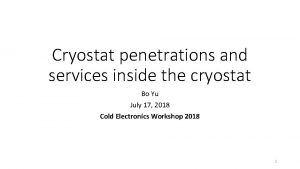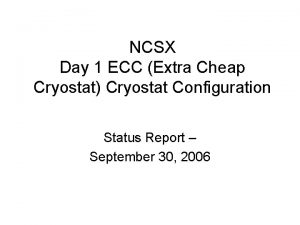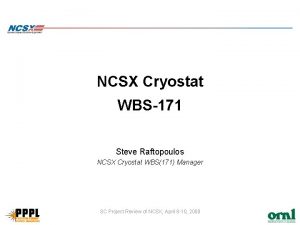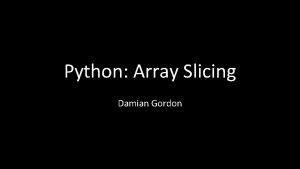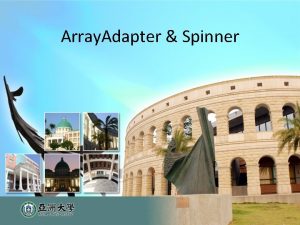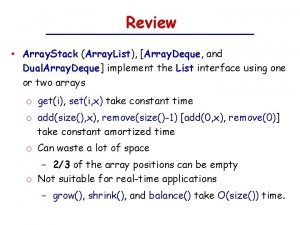Neel IRAM KIDs Array Cryostat Filters Cold electronics






















- Slides: 22

Neel IRAM KIDs Array - Cryostat - Filters - Cold electronics - Measurement methods and assumptions for Sensitivity calculation - Antenna-coupled 42 pixels KIDs (first option) - 32 pixels LEKIDs (second option) - 196 pixels LEKIDs (TBT) - Best LEKIDs pixel tested in Cardiff (for 2010 …)

The Cryostat Optics Designed for f/1. 6 on the detectors (from f/10 at M 8). De-magnifying factor: 6 300 K 1 K 160 K 80 K 4 K 300 K: ZITEX G 110 HDPE (t=10 mm) window Thermal Filter (metal-mesh) 150 K: -- 80 K: 2 thermal filters (metal-mesh) 1 low-pass filter 270 GHz 5 K: 1 low-pass filter 240 GHz L 1 – HDPE lens (t=11 mm) 1 K: 1 low-pass filter 210 GHz 100 m. K: Reflecting Baffle L 2 – HDPE lens (t=12 mm) Low-pass filter 170 GHz High-pass filter 130 GHz 0. 1 K (optional) bandpass 130 -160 GHz optional) bandpass 4 th Sepember 2009: added new 4 K baffle (ECOSORB inside) + ZITEX G 110 at 80 K

The Filters - 4 thermal (including ZITEX) - 4 low-pass - 1 high-pass HDPE window and lenses are not AR-coated. We have 4. 5% loss at each surface, plus 10+11+12 mm Bulk absorption. We estimate THDPE=0. 7 Band: 130 -170 GHz Filters transmission: 0. 5 HDPE transmission: 0. 7 So our best estimation of the in-band transmission is Total Transmission 0. 35

Cold Electronics We can now easily (cabled for both down to 4 K, just has to un-screw the amplifier) change between: - IRAM cryogenic amplifier 1÷ 2 GHz. Tnoise = 5 K. Power dissipated: 50 m. W - LNF cryogenic amplifier 3÷ 9 GHz. Tnoise = 5 K. Power dissipated: 4 m. W Still waiting for the Caltech 1÷ 12 GHz amplifier. Both are mounted at 4 K. The IN of the amplifier is connected to the array with: - 15 cm superconducting Nb. Ti 1. 6 mm semi-rigid COAX (thermalised at 1 K) - 16 cm Copper 2. 2 mm semi-rigid COAX (at 100 m. K)

Measurements « protocol » Everything on XY stage 300 K 160 K 1 K 80 K 4 K 30 x 30 cm ECOSORB 77 K CHOPPER 77 K / 300 K ECOSORB 77 K 580 mm 750 mm 12 mm dia. hole in the 2 nd ECOSORB is to fake M 8 in some way (not perfect) 0. 1 K

Estimation of the power 1/2 Assuming h <<k. T (OK): So, between 300 K and 77 K (perfect emissivity): Pe = 0. 2 m. W/m 2 ( max=170 GHz, min=130 GHz) Power emitted over the 2π, both polarisations, with a cos( ) distribution. For a chopped Φ=12 mm surface (S = 1. 1· 10 -4 m 2) Pchopped = 22 n. W The Lambertian « beam » is propagating forward toward the 4 K lenses, d=80 mm and distance D=750 mm from the chopper. The 4 K lens collects the part going mostly on the focal plane. So the useful fraction of solid angle is: frac = (πd 2/4) / (2πD 2) = (1/8)·(d/D)2 = 1. 4· 10 -3 Total transmission (from the chopped source to the array): - Filter + lenses - Cold pupil cutoff (cutting the external ring) - Measurement system (from chopper to cryostat): - TOTAL TRANSMISSION TFL = 0. 35 TCP = 0. 8 TCH = 0. 5 T = 0. 14 (0. 45 possible) (n. a. on the sky) (0. 36 possible)

Estimation of the power So we have: 2/2 P frac · TTOT · Pchopped 4 p. W Total power, in the two polarisations, hitting the focal plane and spreading (PSF - gaussian 2 -D distribution) on a number of pixels to be determined experimentally (aberrations + diffraction). ZEMAX full 3 -D simulation (better calculating the pupil cut and taking properly into account the Lambertian and extended nature of the emitter). PZEMAX = 5. 9 p. W (Basically estimating frac in 3 -D ray-tracing) Now, the mean beam FWHM is fitted to be 31 mm. It means, roughly, a factor (12/31)2 = 0. 15 Working out the integral of the gaussian in 2 -D we find a factor of 0. 098 instead. So, the power hitting the pixel in this model is 5. 9 · 0. 1 = 0. 59 p. W (2 polarisations) p. W In case of the measurement of the SRON array, since we have used an additional filter 2 mm, we estimate 0. 4 p. W instead of 0. 6 p. W

The antennas 42 (6 x 7) pixels array – XY scan PIXELS identifications: 37/42 working pixels. Mean inter-pixel distance: 10 mm (means f/1. 6 on focal plane, dpixels=1. 6 mm) Mean beam FWHM: 30 mm

The antennas 42 (6 x 7) pixels array: XY scan PIXELS identifications: 37/42 working pixels. Mean inter-pixel distance: 10 mm (means f/1. 6 on detectors plane, dpixels=1. 6 mm) Mean beam FWHM: 29 mm

The antennas array: FPGA sensitivity Sensitivity measured with FPGA electronics, LNA at 4 K mounted, Grenoble Up/Down converter. It seems it’s still limited by the background. . May be some excess phase noise ? NEP are for the 2 polarisations !! Should divide by 2 to be fair. . NEP 1 Hz 2· 10 -15 W/Hz 0. 5 NEP 10 Hz 7· 10 -16 W/Hz 0. 5

The antennas array: Bonn sensitivity From Andrey.

Antennas MKIDs next steps • Improve f-distribution (possible before Oct) – Change to optimum f-distribution on chip – Use e-beam mask (current is optical) • Improve coupling – – Current lens array E=2. 7 instead of 5 (loss 3 d. B) Change extension length (possible before Oct) Change lens material (Spring) Possible to Niquist reduce oversampling (max gain 6 d. B) • Improve F-noise – Integrate capacitor at coupler (demonstrated at JPL) improves phase noise by 10 d. B • Multi frequency pixels (+ kid parametric optimization) • Optimise for operation under sky loading

LEKIDs: 32 pixels focal plane scan 24 working pixels within the 48 MHz band of the FPGA electronics. FWHM = 31+/-4 mm It’s OK !

LEKIDs: 32 pixels unchopped Image of two hot spots on the focal plane; no chopper

LEKIDs: 32 (4 x 8) pixels array (NEP)

LEKIDs: 32 pixels focal plane scan PIXELS identifications: 28 working pixels, but only 24 within the FPGA bandwidth Mean inter-pixel distance: 12 mm (means f/1. 6 on detectors plane, dpixels = 2 mm) Mean beam FWHM: 31 mm

LEKIDs: 196 (14 x 14) pixels array CAREFUL: still to be tested with the Bonn electronics (need to change to 16 k bins) and in the same background conditions. Scheduled when we repair the cryostat. S/N ~ 1000 (down to 0. 5 Hz) S/N ~ 200 (at 0. 1 Hz) but … (dia. pupil 2 cm) Assuming 0. 5 p. W power NEP ~ 5· 10 -16 W/Hz 0. 5 CHOPPER Ongoing to improve: - 16 -32 pixels arrays (FPGA electronics) - Fabrication on Sapphire NO CHOPPER - Change of resonator impedance (phase noise and power handling) - Cryogenic amplifier (amplitude readout) - Better control of backshort distance - Superconducting box + filter (Cardiff) - Post-processing: KIDs circle calibration - Test with Bonn electronics to read-out the whole array.

LEKIDs: Best Pixels Tested Border conditions: - 40 nm film (UHV at SRON). - Less C fingers (helps reducing the phase noise) - Tested in low background environment (Cardiff). (0. 1 p. W per pixel) To further reduce the NEP: - Change the impedance of the resonator - 2 polarisations design - fabricate on sapphire - further optimise the electrical power on the KIDs - use an additional AR coating - optimise the film thickness …. .

Bonn Electronics Available in Grenoble since end of July. Bandwidth: Max. readout rate: FFT points: Bins spacing: 400 MHz 10 Hz 8, 192 / 16, 384 48. 8 / 24. 4 k. Hz Interfaced with Acquisition program OK

Néel FPGA Electronics Bandwidth: Max. readout rate*: Max. number of channels 48 MHz 100 Hz 27 * Can be used also for fast (MHz) read-out. Interfaced with Acquisition program OK

Electronics developments USA Open Source: DAC and ADC boards OK up to Source: 500 MSPS. Developing the CASPER Core. We’ll have two full copies, with the possibility of using them in parallel. Same concept as FPGA readout. Minimal goal: 128 channels each board (256 hopefully) Delivery: end 2009 ? LPSC, Grenoble: Making a « copy » of our FPGA, but with 200 MHz bandwidth and able to read at least 64 channels. Prototype delivery: November ? Bonn: planning 32 k bins and 800 MHz bandwidth. Bonn:

Conclusions Demonstrated NEP is not exceptionally low BUT: - Imaging capabilities OK for both antennas and LEKIDs - Expected better performances on the telescope (background limiting both Qi and qp) - Need to understand real problems at the 30 -m - Developments are ongoing to reduce the NEP. For both LEKIDs and antennas.
 Cryostat
Cryostat Cryostat
Cryostat Cryostat procedure
Cryostat procedure Cryostat processing
Cryostat processing Kids r kids west cobb
Kids r kids west cobb Neel order
Neel order Neel sachdev
Neel sachdev Dr robert neel
Dr robert neel Neel joshi md
Neel joshi md Philip neel
Philip neel Difference between curie temperature and neel temperature
Difference between curie temperature and neel temperature Neel order
Neel order Difference between curie temperature and neel temperature
Difference between curie temperature and neel temperature Neel hajra
Neel hajra Ferromagneti
Ferromagneti Neel bhalala
Neel bhalala Neel rattan halder
Neel rattan halder Excecro
Excecro Photovoltaic array maximum power point tracking array
Photovoltaic array maximum power point tracking array Array dimensi banyak
Array dimensi banyak Menginisialisasi artinya
Menginisialisasi artinya Jagged array
Jagged array Diketahui suatu array segitiga memiliki 4 baris dan kolom
Diketahui suatu array segitiga memiliki 4 baris dan kolom
